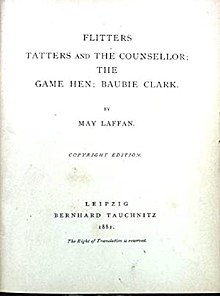| Lady Mary Hartley | |
|---|---|
 "Flitters Tatters and the Counsellor The Game Hen, Baubie Clark" "Flitters Tatters and the Counsellor The Game Hen, Baubie Clark" | |
| Born | 3 May 1849 Dublin, Ireland |
| Died | 23 June 1916 Dublin, Ireland |
| Pen name | Mary Laffan, May Laffan |
| Occupation | Writer |
| Nationality | Irish |
| Genre | slum fiction |
May Hartley (née Laffan) (3 May 1849 – 23 June 1916) was an Irish realist writer who wrote about Dublin society in the nineteenth century and was considered a pioneer of "slum fiction" in an Irish setting.
Career
Born on 3 May 1849 to Michael Laffan and Ellen Saran Fitzgibbon in Dublin, Hartley was educated in the Dominican Convent of Sion Hill and Alexandra College. She had an older brother, William, two younger brothers, Michael and James, as well as two younger sisters, Ellen Sarah and Catherine. After school Hartley worked with Fr. Meehan as a social worker in the Liberties. She also began writing with articles such as 'Convent Boarding Schools for Young Ladies' submitted to Fraser's Magazine (June 1874).
She began writing novels but her early work was poorly received and she had a breakdown. However she continued to write and publish novels. She was also active in the Society for Prevention of Cruelty to Children.
In 1880 Fannie Gallaher published her early novel Katty the flash: a mould of Dublin mud. It was published under the pseudonym of Sydney Starr. Katty the Flash was successful and it was republished in the New York Sun who attributed their heavily amended story to Laffan.
Gallaher's letter of protest about the plagiarism and the unwelcome changes to her story was published in 1883. The New York Sun's editor was criticised by the Weekly Irish Times. The confusion continued with a modern index still attributing Gallaher's story to Hartley.
In 1882 she married Walter Noel Hartley who was a chemistry professor at King's College, London and Fellow of the Royal Society. During her marriage she was no longer writing very much. Her issues with mental health continued and in 1910 Hartley was admitted to Bloomfield Hospital. Her husband was knighted in 1911 and died suddenly in 1913. They had one son, Walter John Hartley. Born 25 April 1889, he was killed in Gallipoli, a captain in the Royal Irish Fusiliers, 16 August 1915.
Death and legacy
Lady Mary Hartley died in hospital in 1916. An anthology notes that Laffan (and Gallaher)'s works described Irish urban settings in a way that was continued by James Joyce and James Stephens.
Bibliography
- Hogan, M.P. (London: Macmillan 1876)
- The Hon. Miss Ferrard (1877; 2nd edn. London: Macmillan 1881)
- The Game Hen Flitters, Tatters, and the Counsellor: Three Waifs from the Dublin Streets (1879; 2nd edn. London: Simpkin & Marshall 1883)
- A Singer's Story (1885)
- Ismay's Children (1887)
- Christy Carew (1880; London: Macmillan 1882)
Further reading
- James H. Murphy (1997). Catholic Fiction and Social Reality in Ireland, 1873–1922. Greenwood Publishing Group. pp. 36–. ISBN 978-0-313-30188-9.
- James H. Murphy (13 January 2011). Irish Novelists and the Victorian Age. Oxford University Press. pp. 163–. ISBN 978-0-19-959699-7.
- Helena Kelleher Kahn (1 January 2005). Late Nineteenth-century Ireland's Political and Religious Controversies in the Fiction of May Laffan Hartley. ELT Press, University of North Carolina at Greensboro. ISBN 978-0-944318-18-8.
- Paddy Lyons; John Miller; Willy Maley (17 October 2013). Romantic Ireland: From Tone to Gonne; Fresh Perspectives on Nineteenth-Century Ireland. Cambridge Scholars Publishing. pp. 238–. ISBN 978-1-4438-5358-3.
- Luke Gibbons (13 November 2015). Joyce's Ghosts: Ireland, Modernism, and Memory. University of Chicago Press. pp. 250–. ISBN 978-0-226-23620-9.
- Brendan Walsh (1 September 2014). Knowing Their Place: The Intellectual Life of Women in the 19th Century. History Press. pp. 76–. ISBN 978-0-7524-9871-3.
- David Dickson (17 November 2014). Dublin: The Making of a Capital City. Harvard University Press. pp. 613–. ISBN 978-0-674-74444-8.
- John Bew (1 September 2012). Castlereagh: A Life. Oxford University Press. pp. 599–. ISBN 978-0-19-997724-6.
- Kali Israel (2002). Names and Stories: Emilia Dilke and Victorian Culture. Oxford University Press. pp. 308–. ISBN 978-0-19-802864-2.
- W.B. Yeats (24 October 1989). Letters to the New Island: A New Edition. Palgrave Macmillan UK. pp. 193–. ISBN 978-1-349-09425-7.
- Robert Welch; Bruce Stewart (1996). The Oxford Companion to Irish Literature. Clarendon Press. ISBN 978-0-19-866158-0.
References
- "Death Certificate" (PDF). Https. Retrieved 21 October 2016.
- ^ "Mrs May Hartley (1849–1916)". Ricorso.net. Retrieved 21 October 2016.
- ^ Angela Bourke (2002), The Field Day Anthology of Irish Writing, NYU Press, pp. 974–, ISBN 978-0-8147-9907-9
- Ciaran O'Neill (12 June 2014). Catholics of Consequence: Transnational Education, Social Mobility, and the Irish Catholic Elite 1850–1900. OUP Oxford. pp. 162–. ISBN 978-0-19-101746-9.
- ^ John Sutherland (13 October 2014). The Longman Companion to Victorian Fiction. Taylor & Francis. pp. 348–. ISBN 978-1-317-86332-8.
- Starr, Sydney (1880). Katty the flash: a mould of Dublin mud. M. H. Gill & Son.
- ^ "Gallaher, Francesca (Fannie) Mary | Dictionary of Irish Biography". www.dib.ie. Retrieved 11 October 2022.
- ^ Deane, Seamus; Carpenter, Andrew; Bourke, Angela; Williams, Jonathan (1991). The Field Day Anthology of Irish Writing. NYU Press. p. 927. ISBN 978-0-8147-9907-9.
- "Former Fellows Of The Royal Society Of Edinburgh. 1783–2002" (PDF). The Royal Society of Edinburgh. p. 423. Retrieved 22 October 2016.
- "National Archives: Census of Ireland 1911". Census.nationalarchives.ie. Retrieved 21 October 2016.
- "Military will for WJ Hartley" (PDF). Willcalendars.nationalarchives.ie. Retrieved 22 October 2016.